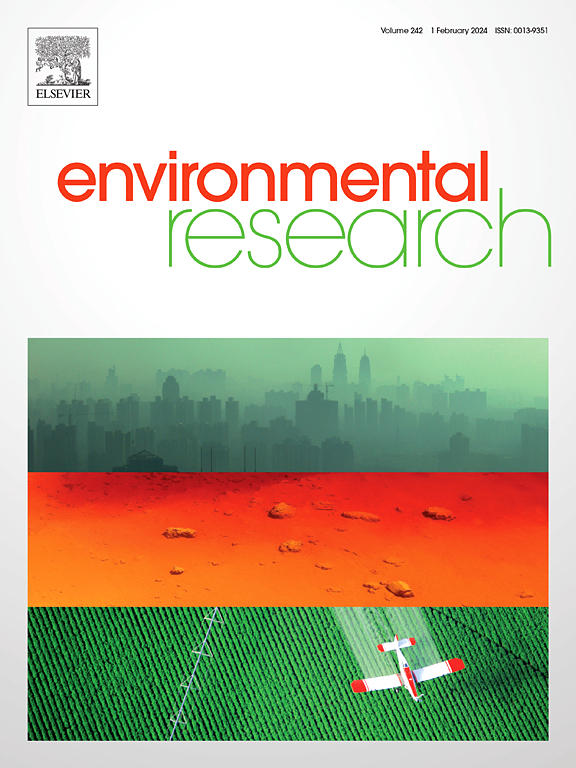Blood metal(loid)s, haemoglobin and goitre in pregnant women from the mercury-exposed and non-exposed environment (Aidarken area vs Kara-Suu area; Kyrgyz Republic)
IF 7.7
2区 环境科学与生态学
Q1 ENVIRONMENTAL SCIENCES
引用次数: 0
Abstract
Objectives
Aidarken is a region with mercury production from cinnabar and, to a lesser extent, from mercury-antimony-fluorite and waste recycling. Recent smelting emissions of elemental Hg vapour are low; however, combined with past pollution legacies, anaemia and iodine deficiency, the health effects for vulnerable populations are still possible. The study aimed to evaluate metal(loid)s status in Aidarken pregnant women vs those from an Hg-noncontaminated region.
Methods
90 pregnant women (3rd trimester) aged 19–39 years were recruited into the cross-sectional study: Aidarken (n = 55) and Hg-uncontaminated Kara-Suu (n = 35) region. The fasting blood samples were analysed for 22 metal(loid)s by ICP-MS and haemoglobin. The difference in metal(loid) levels between the groups (and within groups according to the presence of goitre) was estimated by multiple variable linear regression models.
Results
Metal(loid) blood levels were within reference ranges. We estimated the statistical significance of between-group differences for several metal(loid)s. Essential S, P, Fe, Ca, Mg, Co and Se and non-essential Hg, U, As, Cs and Rb were higher in the exposed than in the control group. On the contrary, the essential Na and Cu, and nonessential Sr and Ba were lower in the exposed vs controls. Mean haemoglobin levels didn't differ between the groups, while the incidence of goitre was higher in the exposed group (34.6 % vs 11.4 %). In the exposed group, the presence of goitre was estimated as a possible predictor for higher levels of Hg, Rb, Mn, Fe and Se.
Conclusions
We found no critical Hg-related health concern for Aidarken pregnant women. The nutritional status of some essential metal(loid)s was even better in the exposed than in the control group. However, the results may indicate that long-term chronic exposure to moderate Hg levels could worsen thyroid health issues in a given environmental (iodine-deficient region) and lifestyle (suboptimal use of iodinated salt) conditions.
汞暴露和非汞暴露环境中孕妇的血金属(样蛋白)、血红蛋白和甲状腺肿(aidarken地区vs kara-suu地区);吉尔吉斯共和国)。
目的:艾达肯是一个以朱砂为原料生产汞的地区,在较小程度上也以汞锑萤石和废物回收为原料生产汞。单质汞蒸气近期冶炼排放较低;然而,再加上过去的污染遗留问题、贫血和缺碘,脆弱人群的健康仍有可能受到影响。该研究旨在评估Aidarken孕妇与来自未受汞污染地区孕妇的金属(样蛋白)状况。方法:90名19-39岁的妊娠晚期妇女被纳入横断面研究:Aidarken (n=55)和Kara-Suu (n=35)地区。用ICP-MS和血红蛋白分析空腹血样中22种金属(样蛋白)。通过多元线性回归模型估计组间(以及组内根据甲状腺肿的存在)金属(样蛋白)水平的差异。结果:血中金属(样蛋白)含量均在参考范围内。我们估计了几种金属(样蛋白)组间差异的统计学意义。接触者体内必需的S、P、Fe、Ca、Mg、Co和Se以及非必需的Hg、U、As、Cs和Rb含量高于对照组。与对照组相比,暴露组必需Na、Cu和非必需Sr、Ba含量较低。两组之间的平均血红蛋白水平没有差异,而暴露组甲状腺肿的发生率更高(34.6%对11.4%)。在暴露组中,甲状腺肿的存在估计是汞、铷、锰、铁和硒水平较高的可能预测因素。结论:我们发现Aidarken孕妇没有严重的与hg相关的健康问题。一些必需金属(类铁)的营养状况在暴露组甚至比对照组更好。然而,研究结果可能表明,在特定的环境(缺碘地区)和生活方式(不理想的碘盐使用)条件下,长期慢性暴露于中等水平的汞可能会恶化甲状腺健康问题。
本文章由计算机程序翻译,如有差异,请以英文原文为准。
求助全文
约1分钟内获得全文
求助全文
来源期刊

Environmental Research
环境科学-公共卫生、环境卫生与职业卫生
CiteScore
12.60
自引率
8.40%
发文量
2480
审稿时长
4.7 months
期刊介绍:
The Environmental Research journal presents a broad range of interdisciplinary research, focused on addressing worldwide environmental concerns and featuring innovative findings. Our publication strives to explore relevant anthropogenic issues across various environmental sectors, showcasing practical applications in real-life settings.
 求助内容:
求助内容: 应助结果提醒方式:
应助结果提醒方式:


